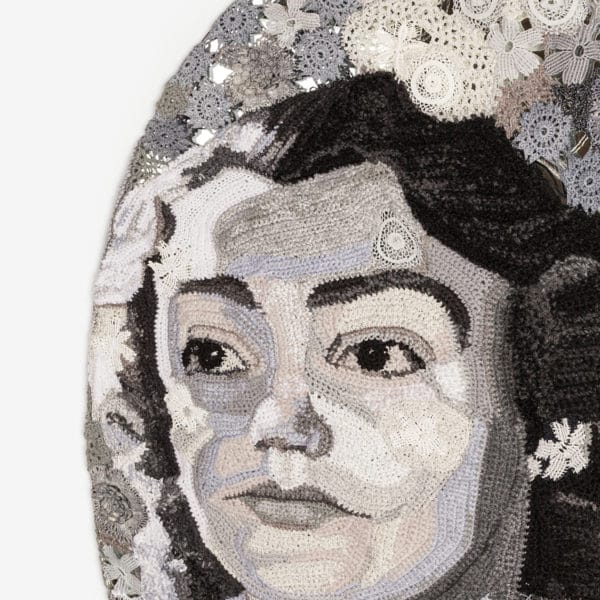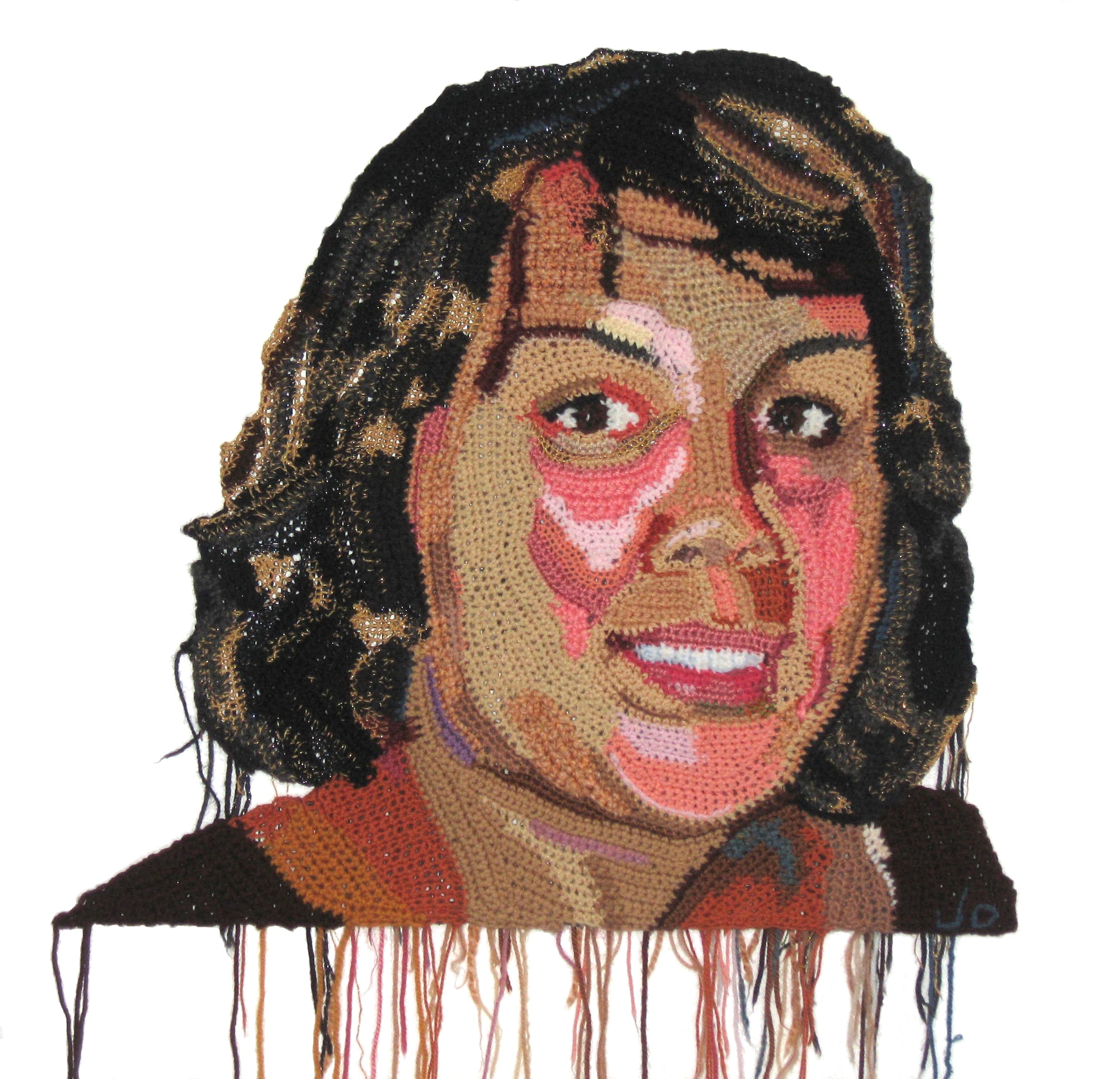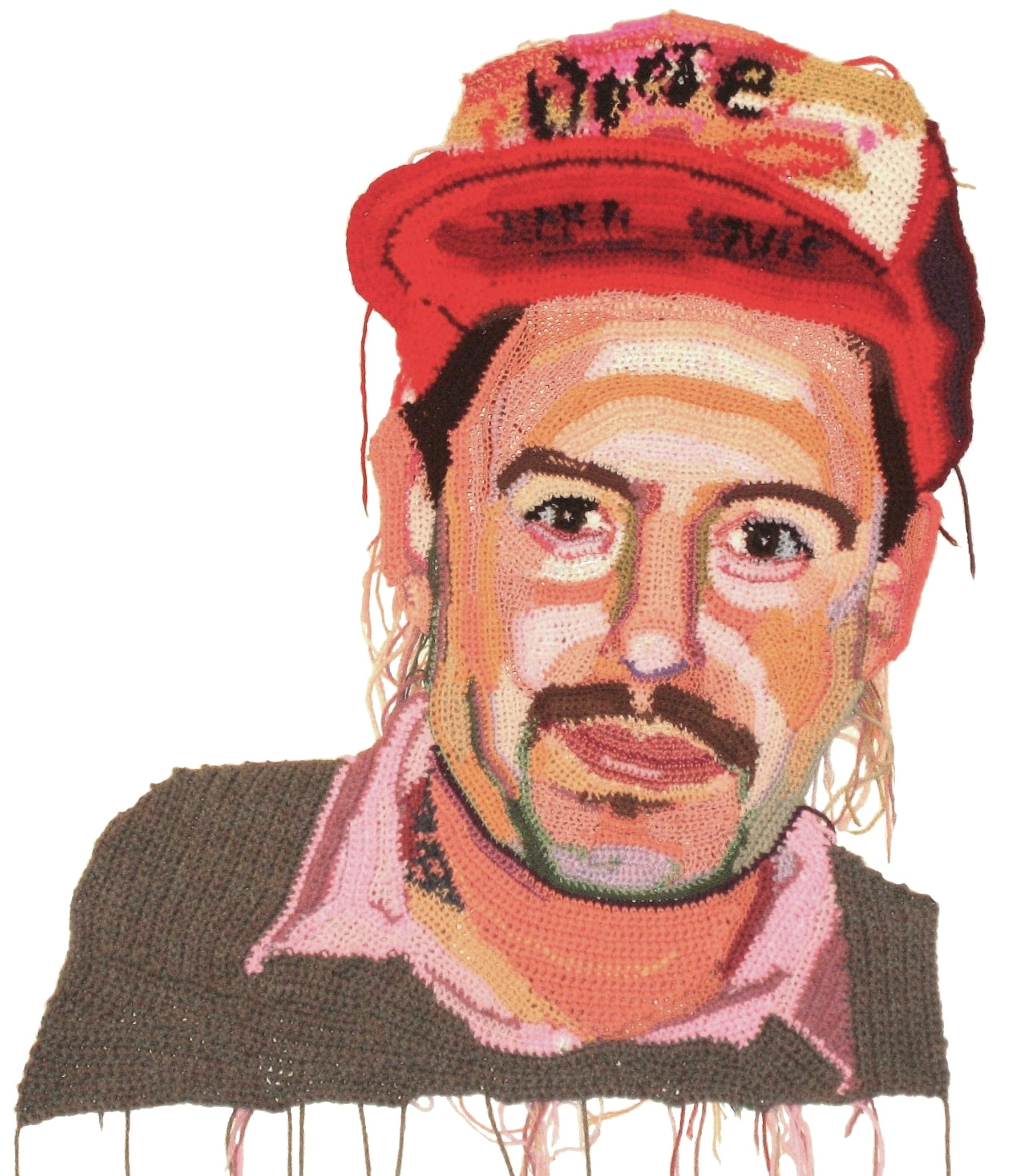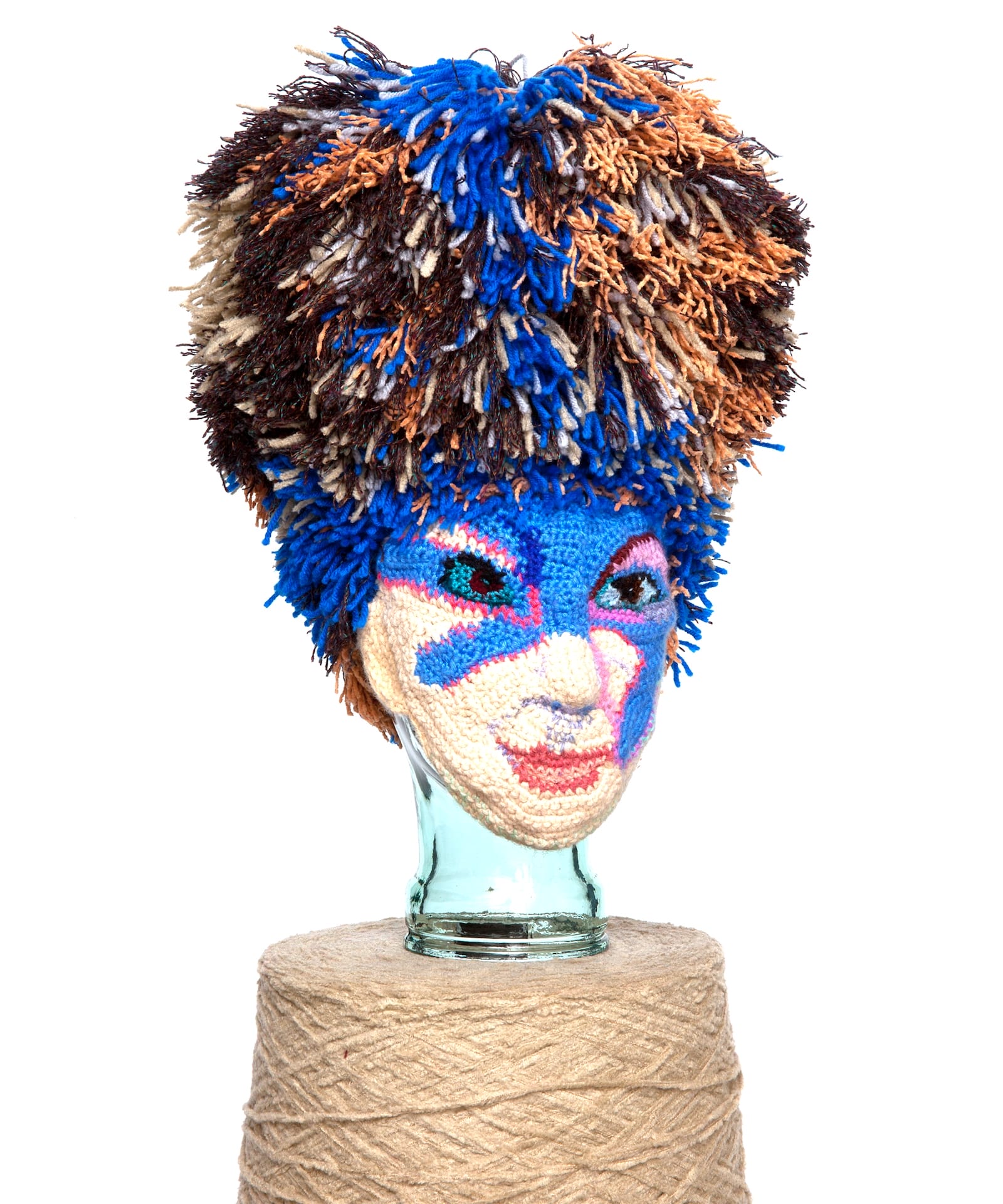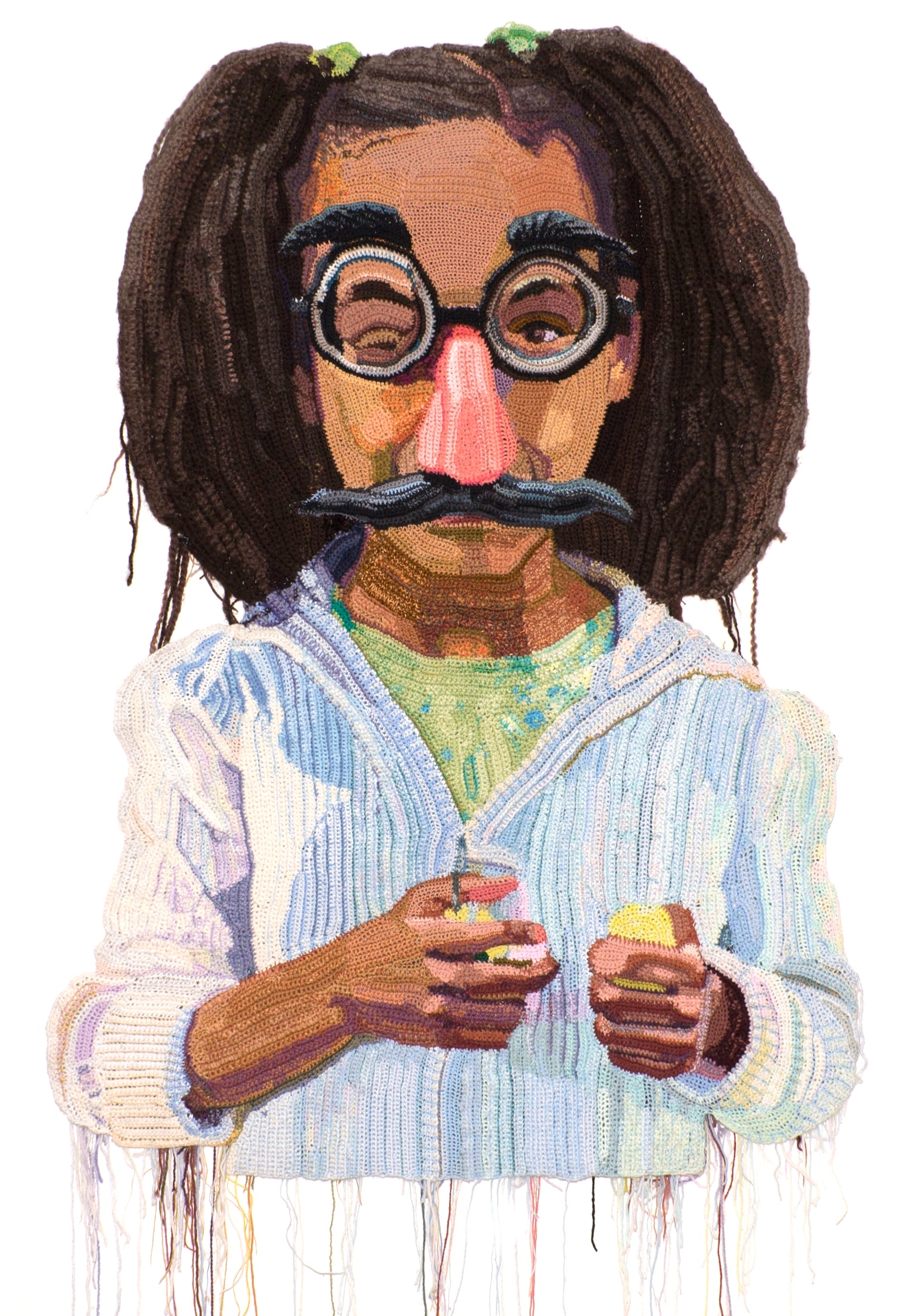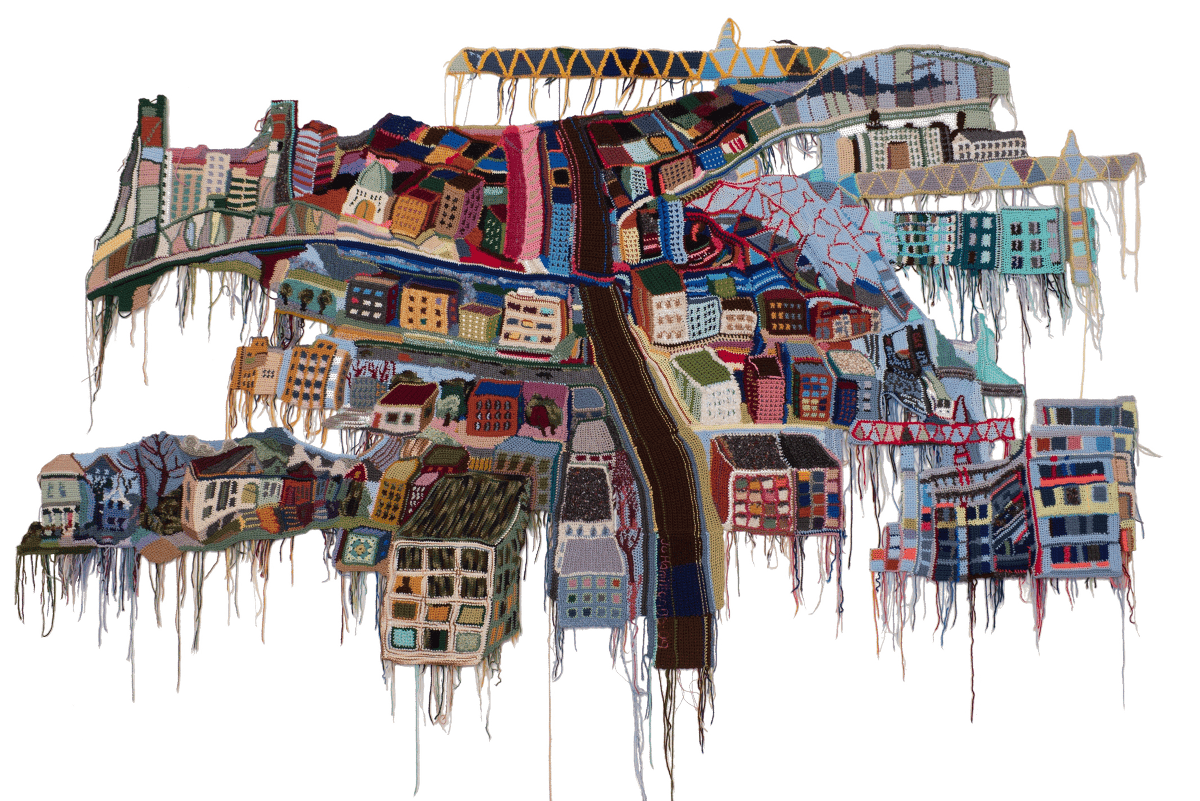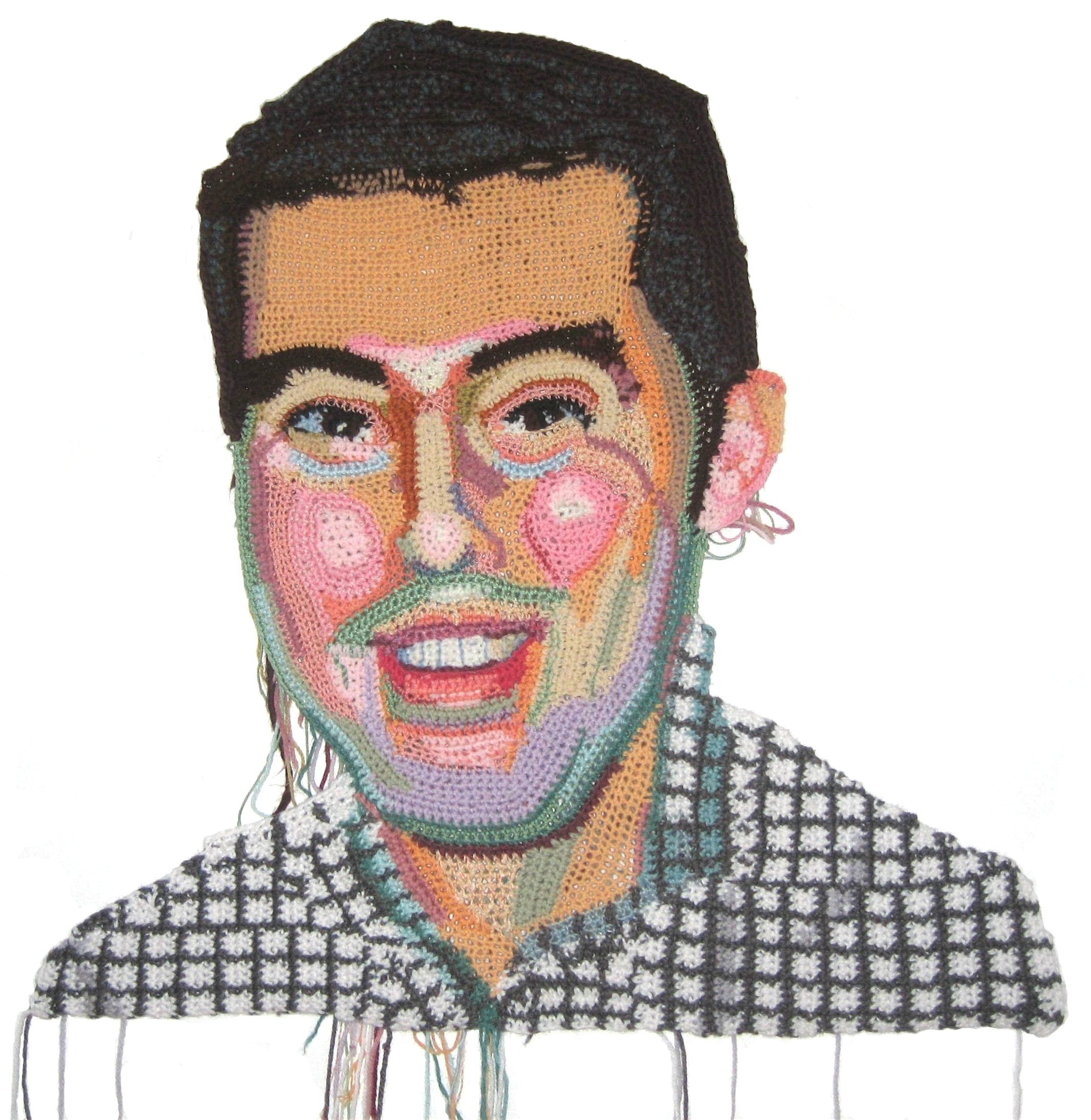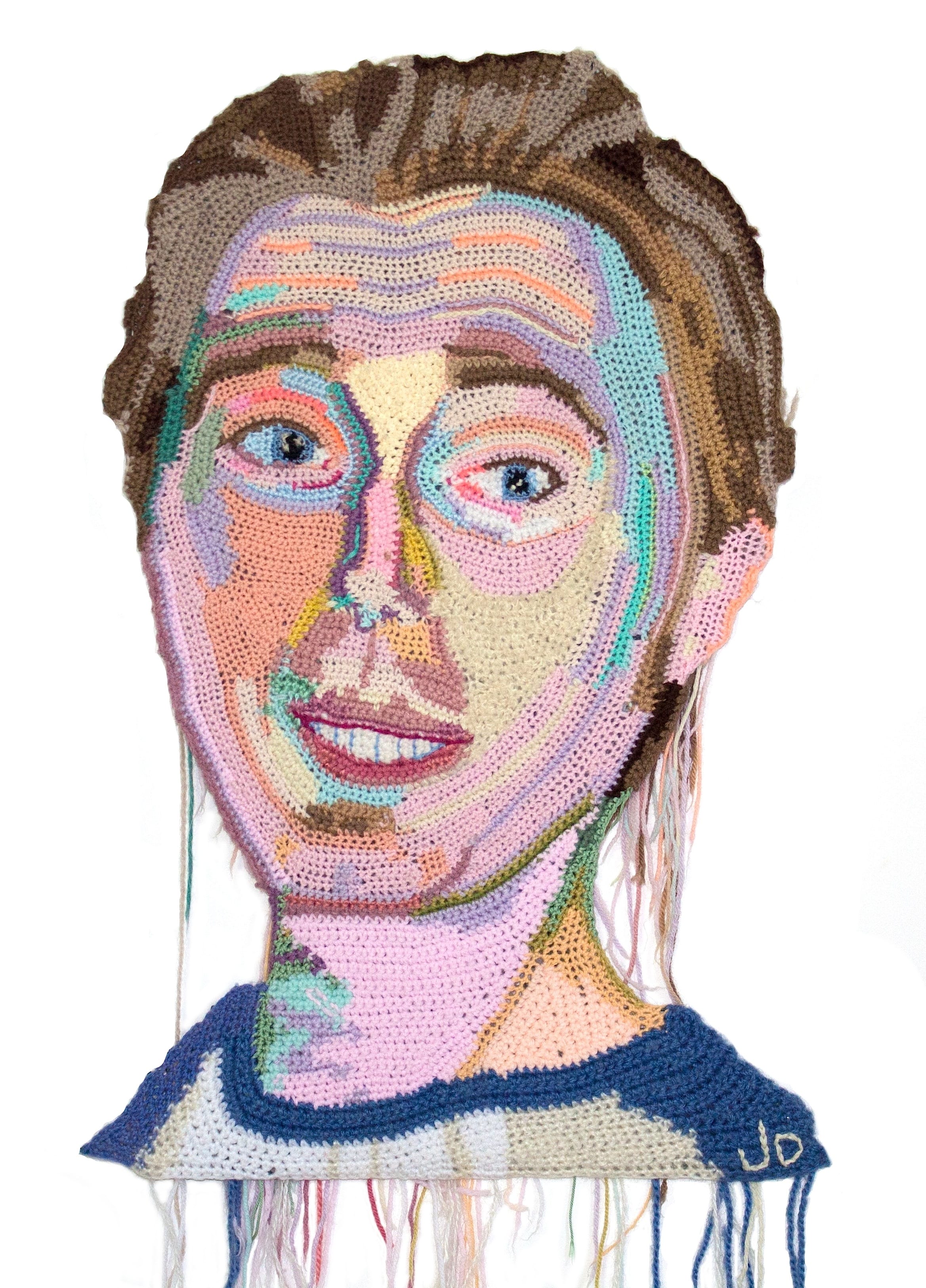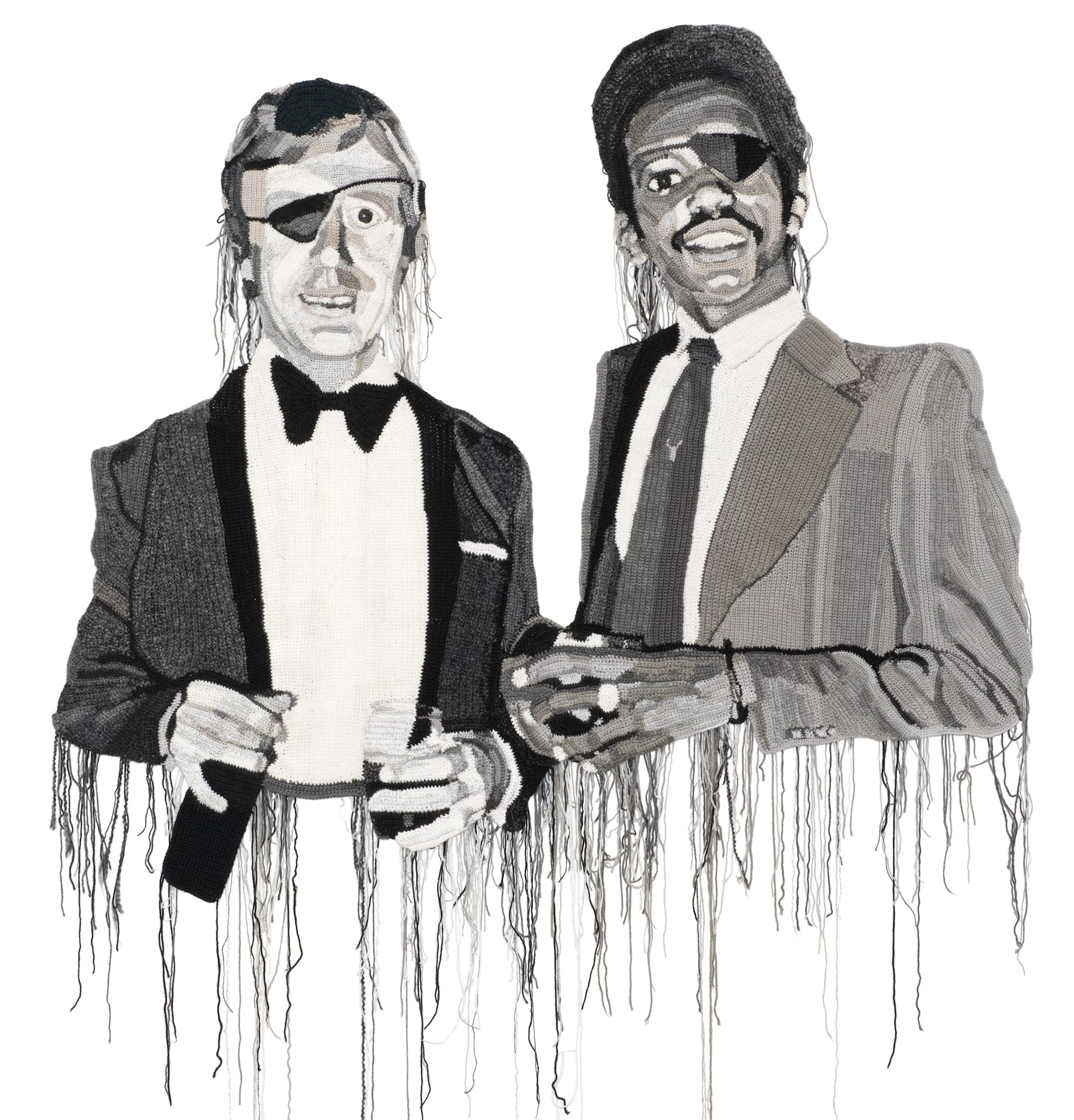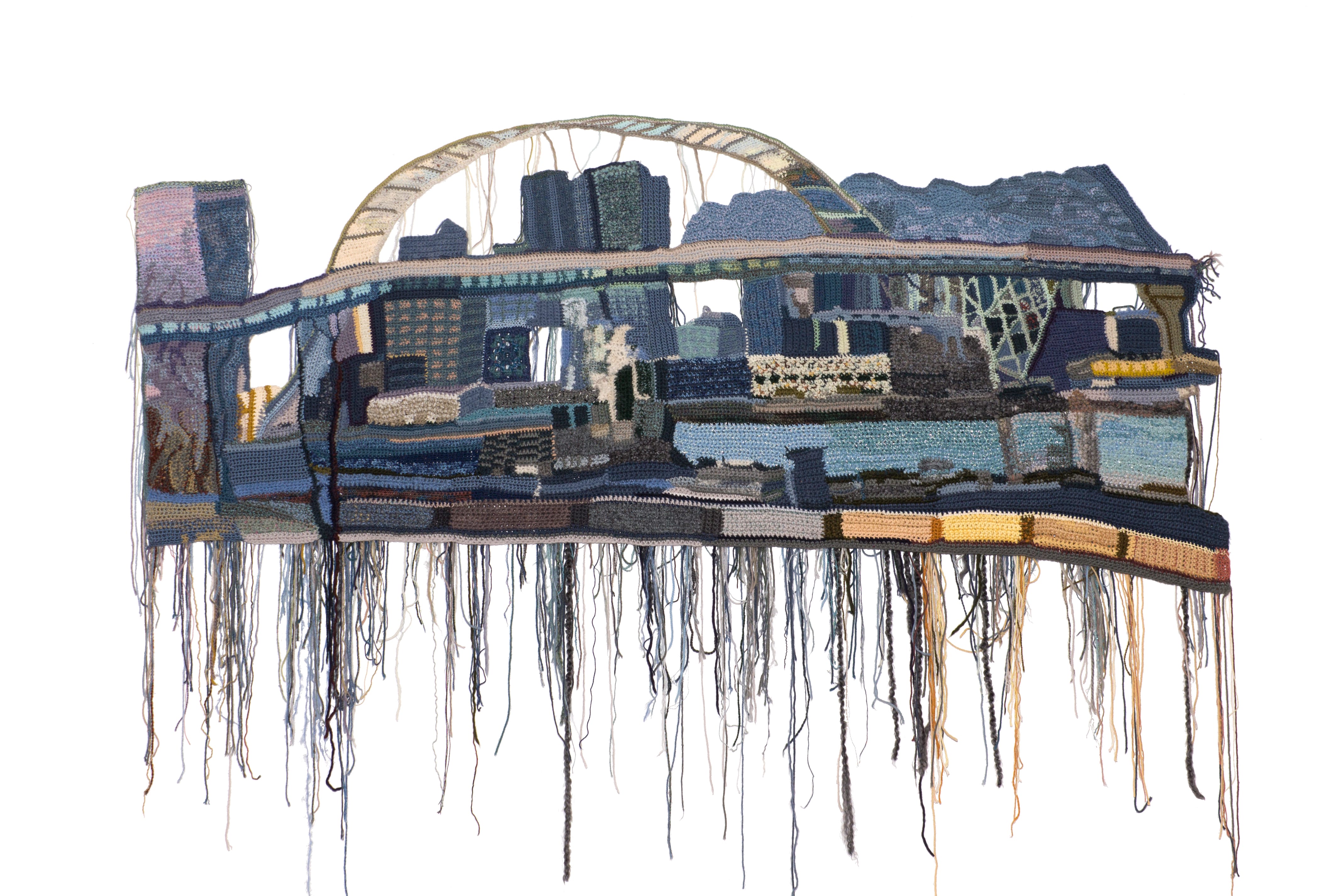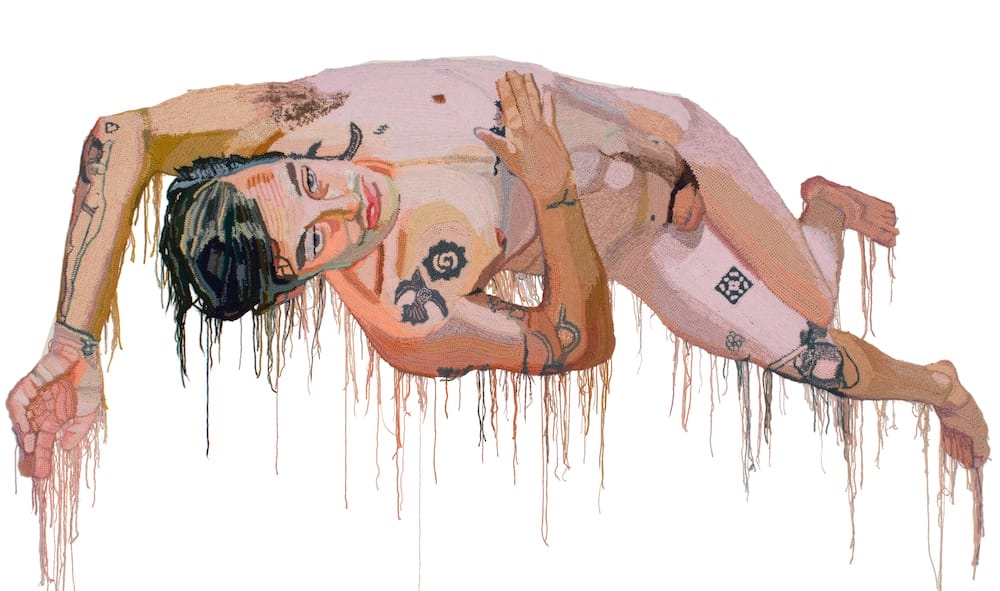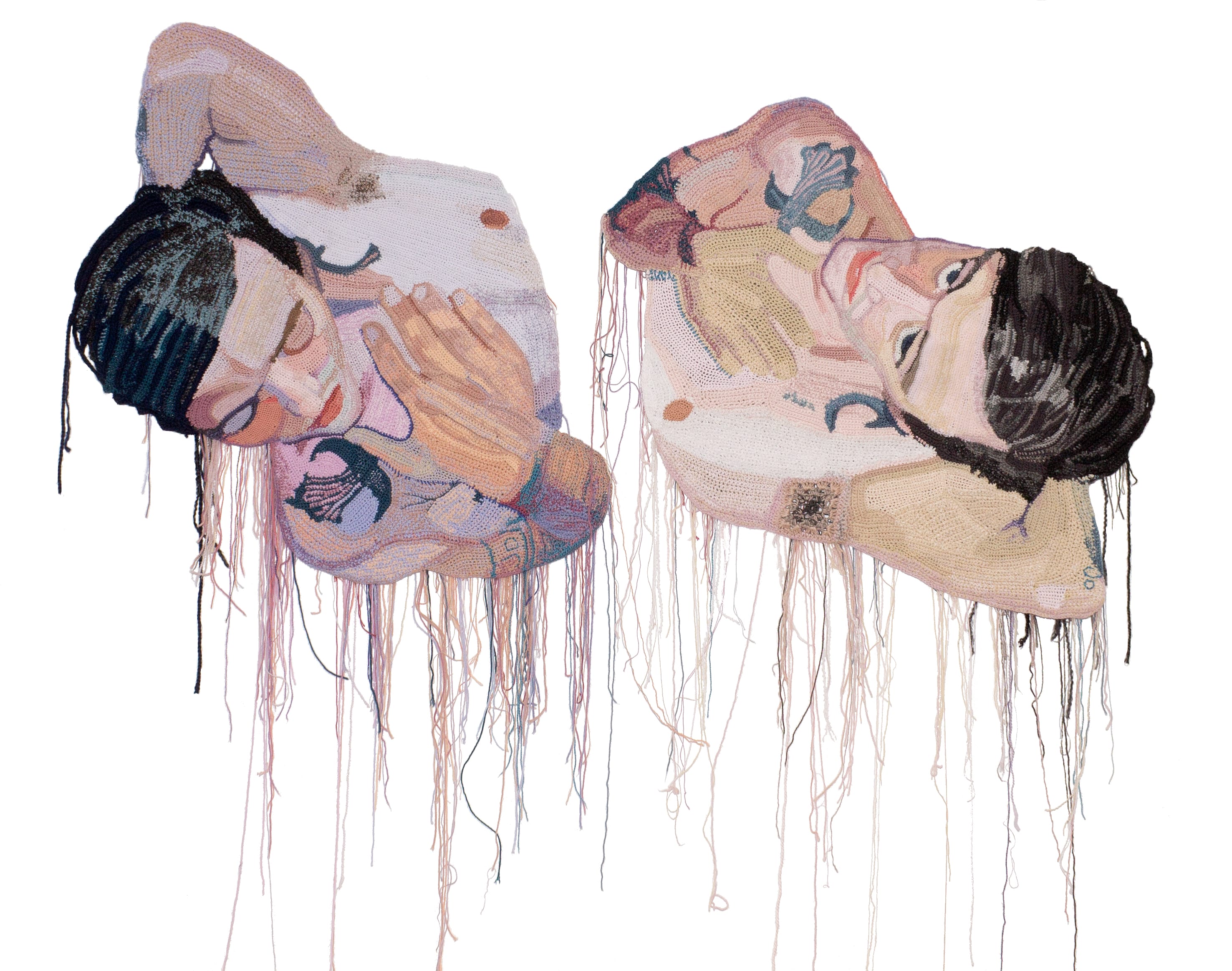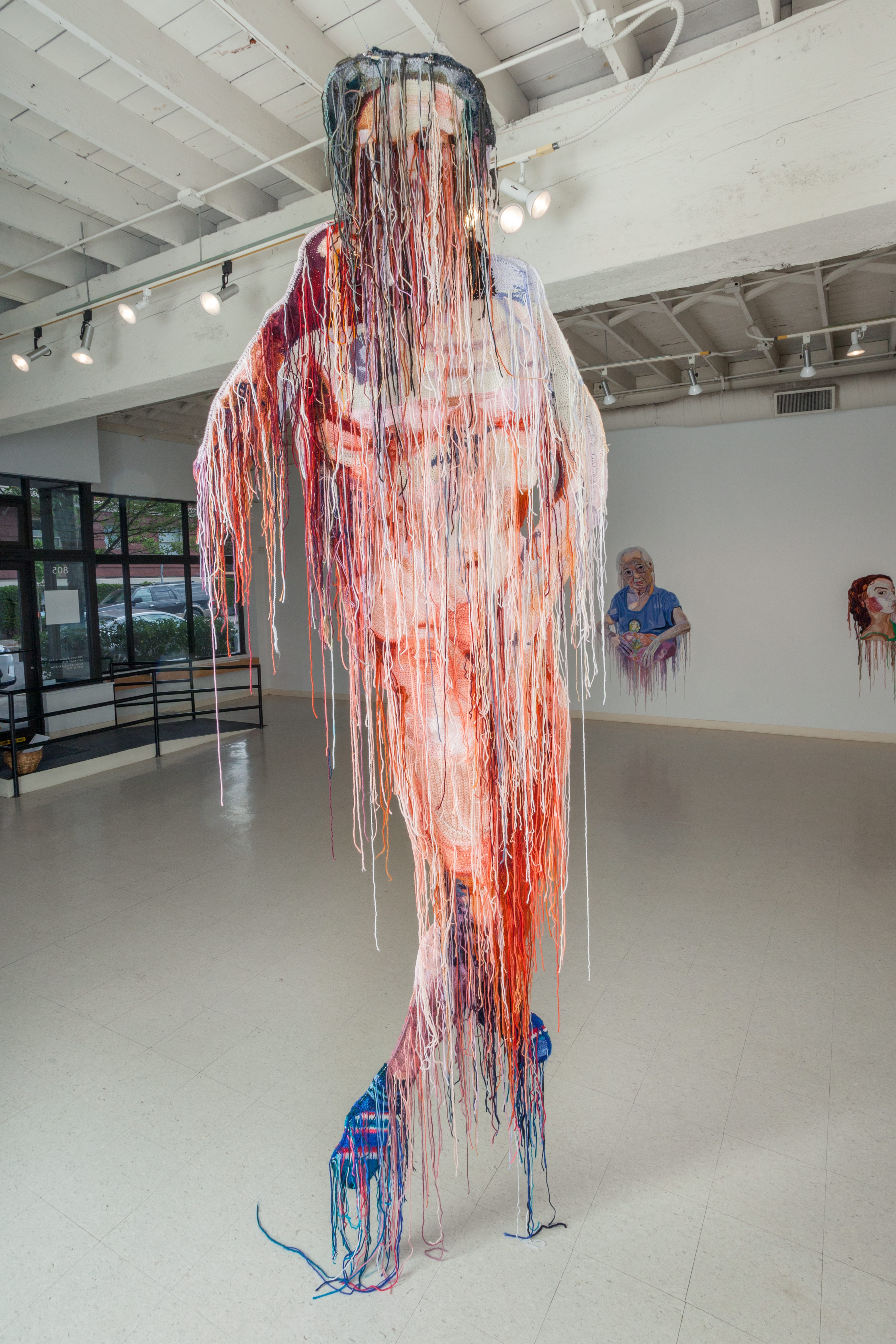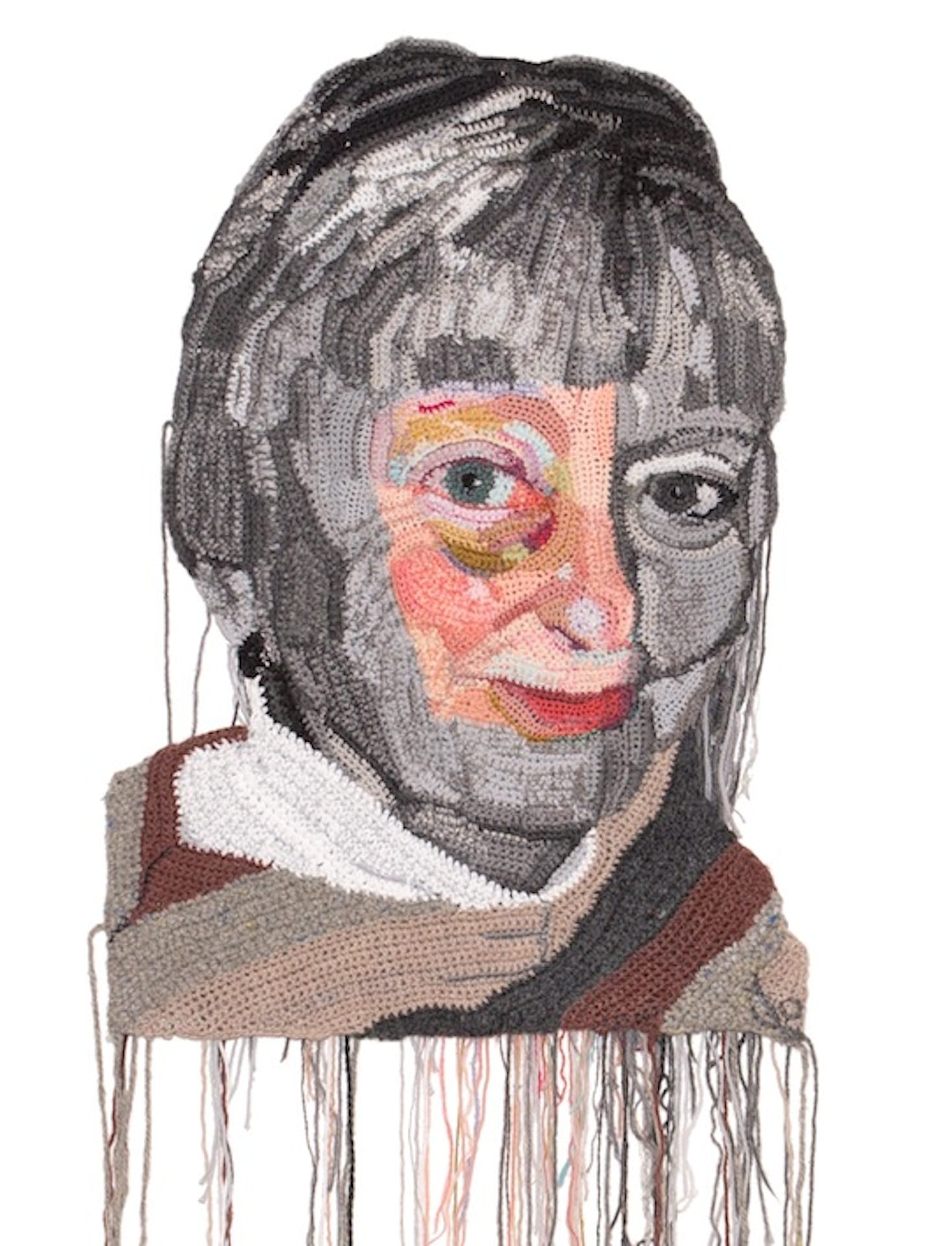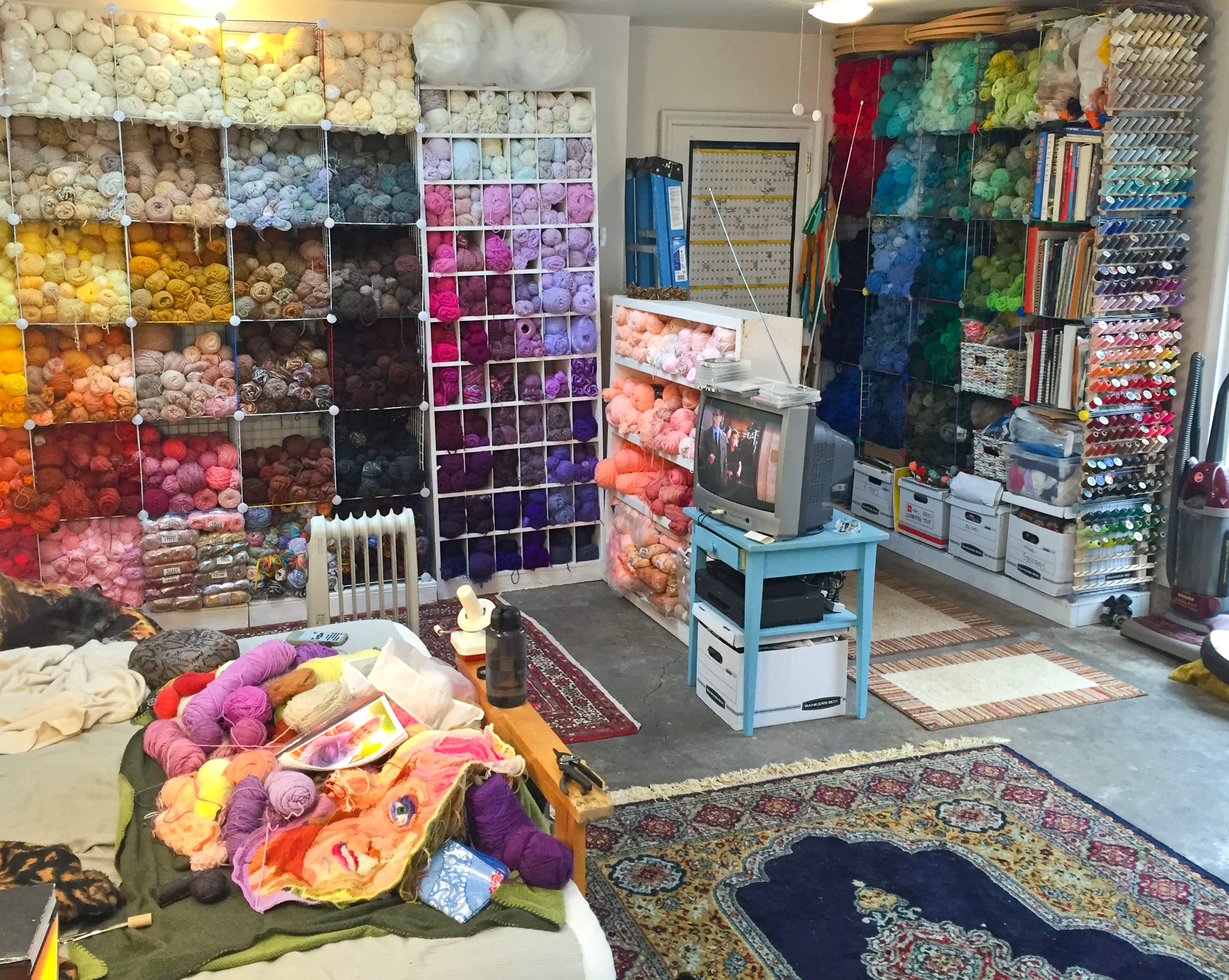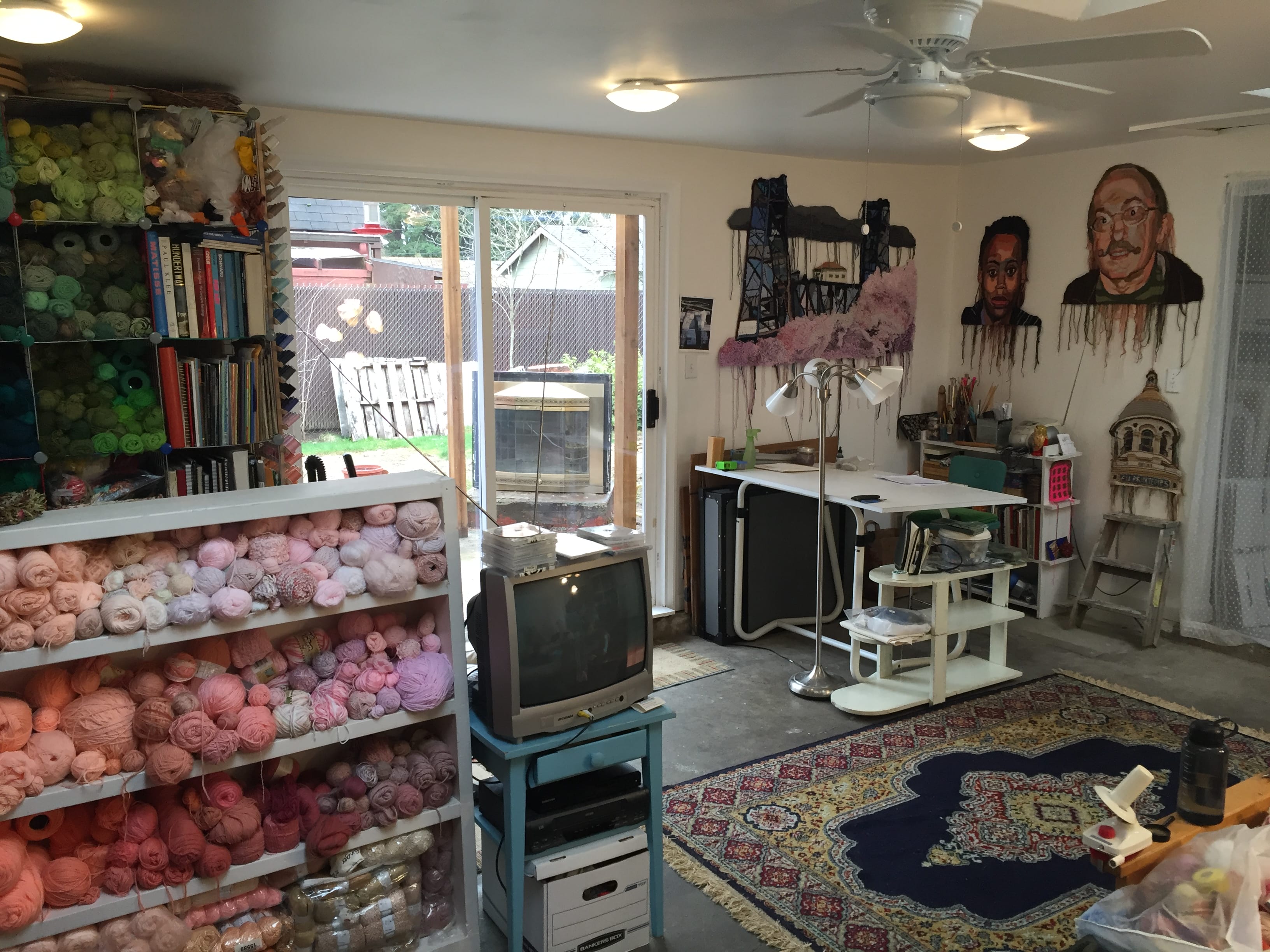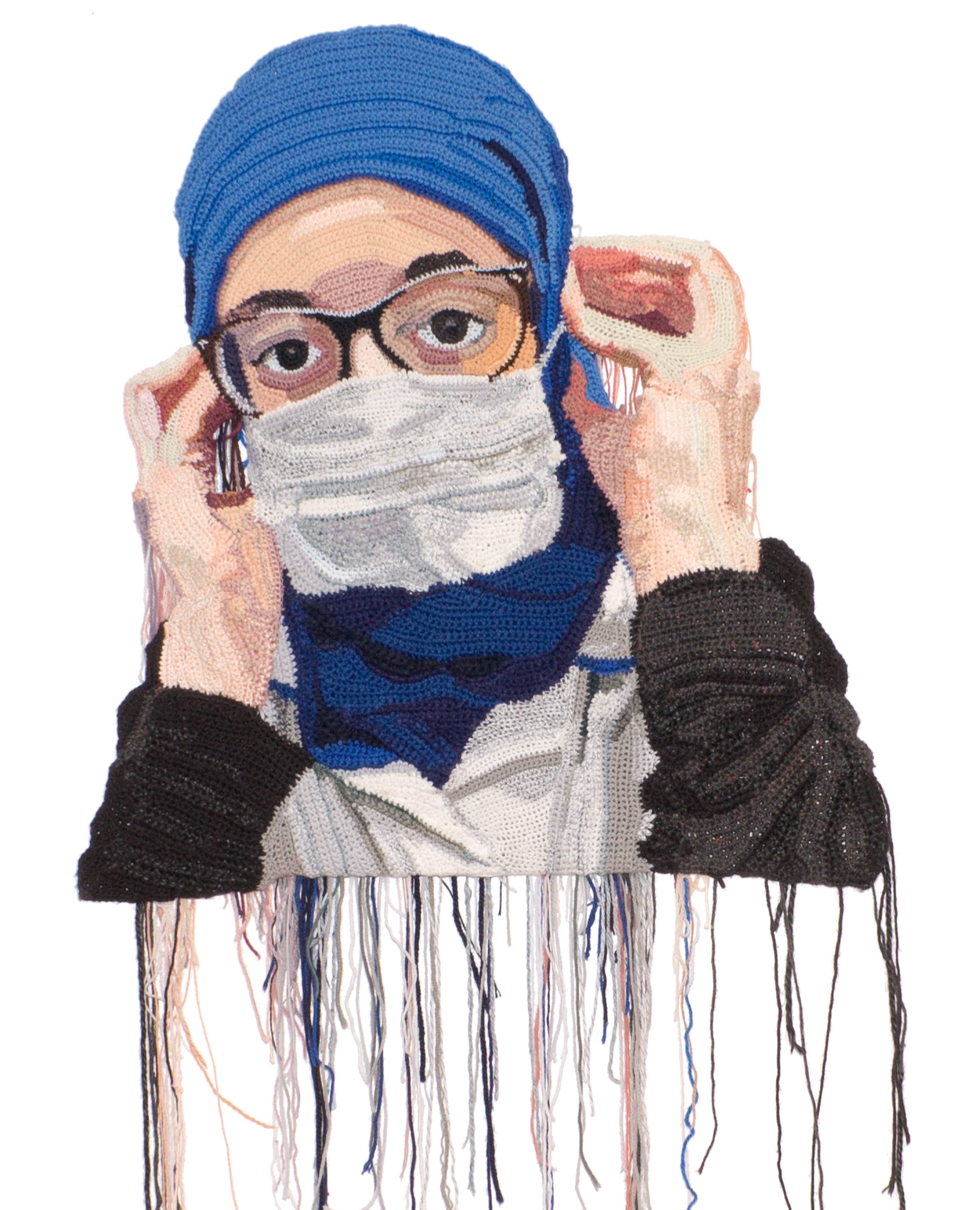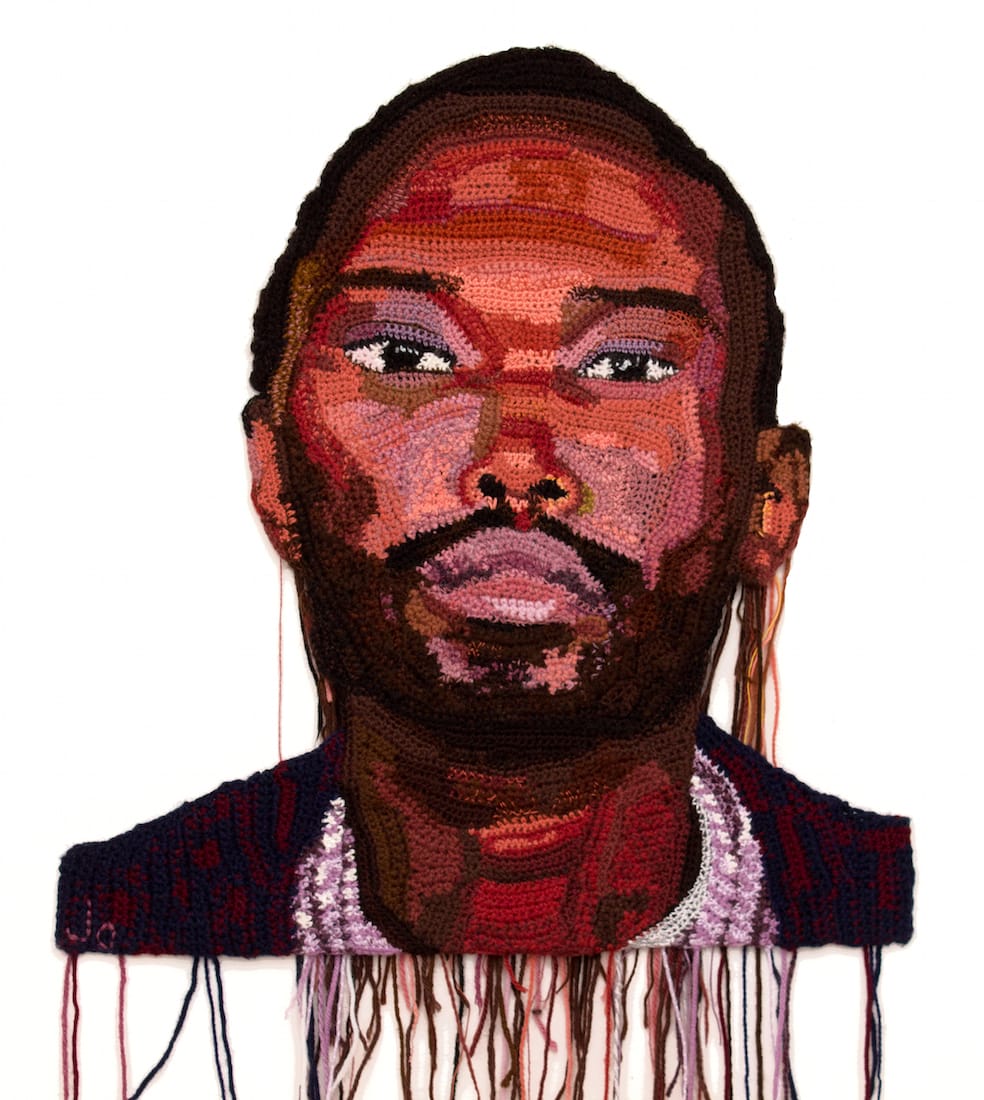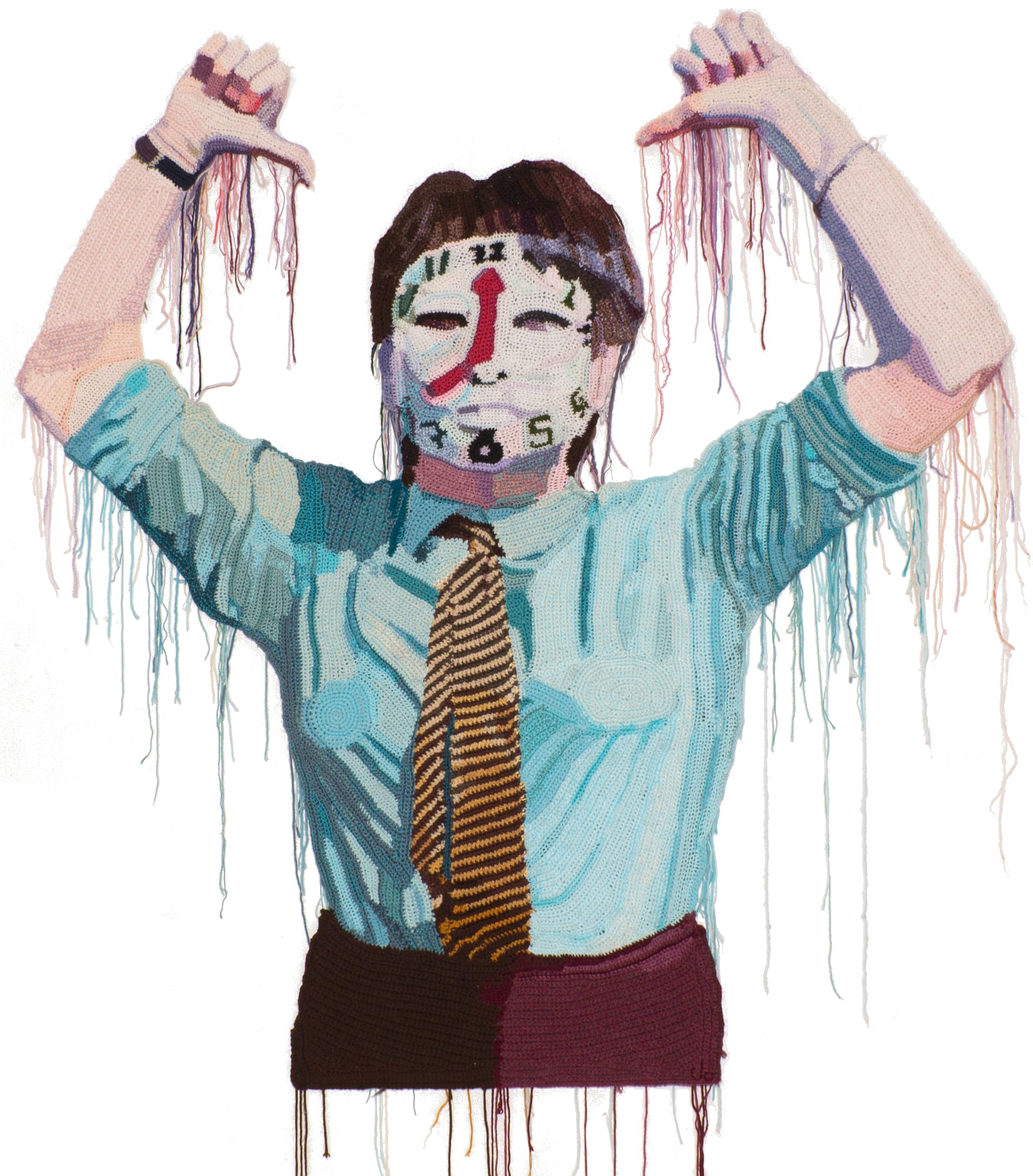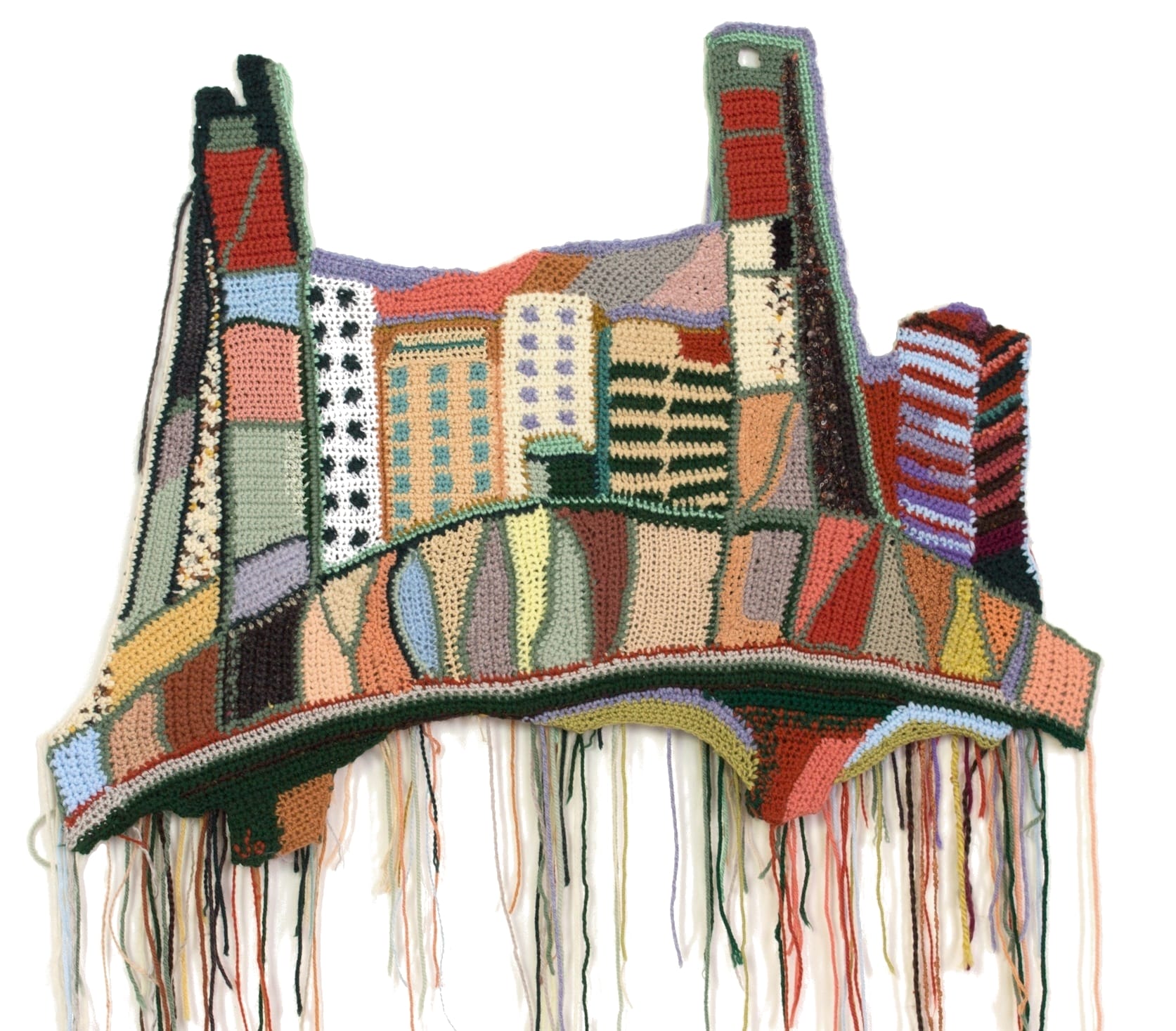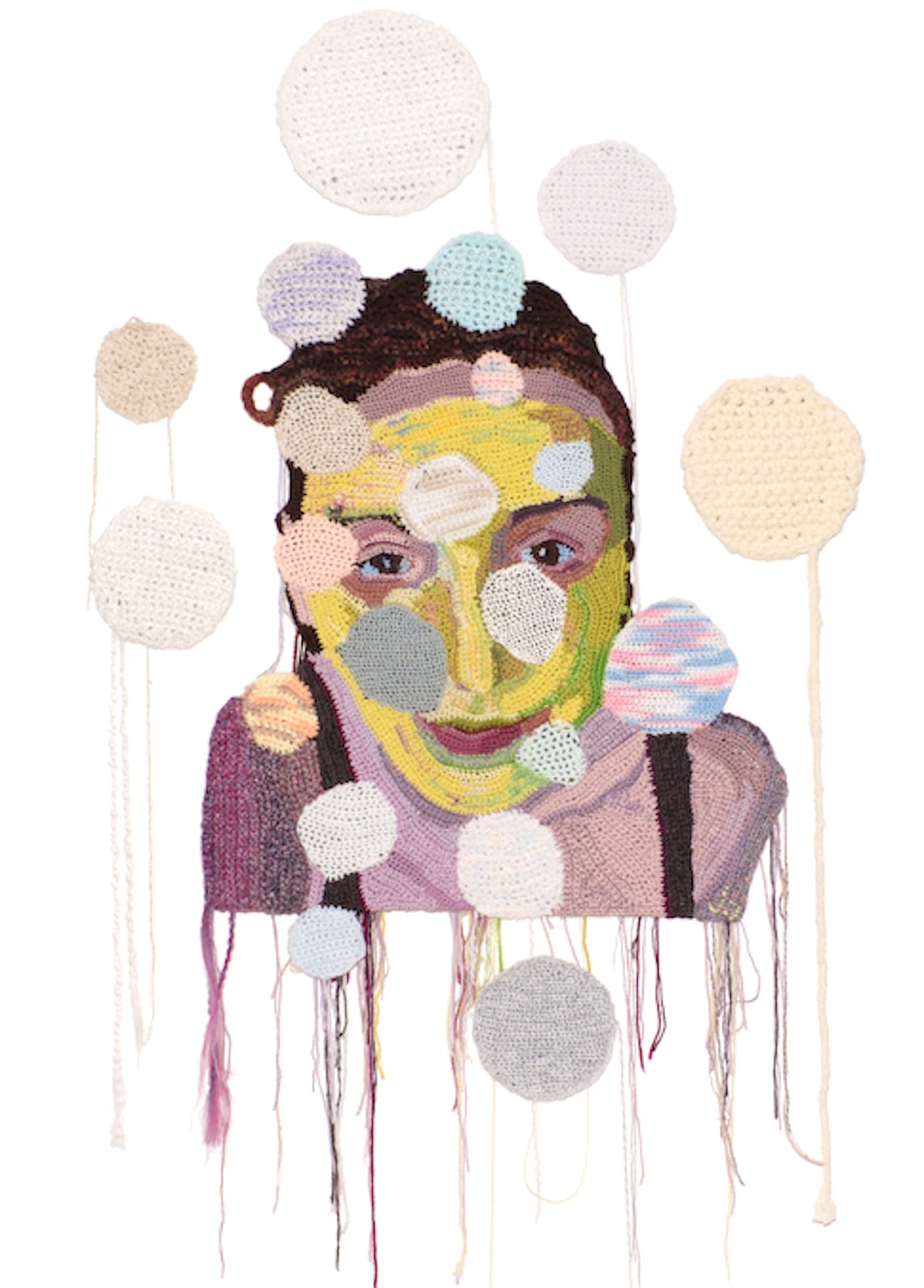Interview with Jo Hamilton

Jo Hamilton is an artist who is originally from Glasgow (Scotland) and who now lives and works in Portland (Oregon).
After having trained at the Glasgow School of Art and having experimented with various artistic techniques such as painting and drawing, she discovered that she could best express her artistic vision through the traditional technique of crochet. Thanks to the use of yarns of various nature and multiple colors, Jo creates contemporary portraits, urban landscapes and large male nudes, intertwining tradition with a modern and impressive style.
Below is the link to the artist’s website:
https://www.johamiltonart.com/
Can you tell us something about yourself and your history as an artist? How did you start?
I was always interested in art from a young age, I drew all the time and constantly made things. My mum and my gran taught me to knit and crochet when I was about six, and I took crochet up again as a teenager, a year or two before I started at Glasgow School of Art in 1989. At that time we had to specialise after our first year, so at 18 I focused on drawing and painting for the remainder of my BFA. During that time I began to feel that painting was not the right medium for me and I started experimenting with different ways to make art. I took film and video classes, and did lot of writing, as well as continuing to draw and paint. After graduation I was looking for an adventure and I ended up traveling across the United States and in landed in the pacific northwest, in Portland, Oregon. I fell in love with the town and eventually moved there for good in 1996. Back then, like many young artists in Portland I first showed my work in bars and restaurants around town. It got good responses, but I kept searching for my yet-to-be-discovered medium.
“Agnes ‘Nancy’ Robb (Gran)”Mixed crocheted yarn 44×30 inches 2018 (A portrait of my grandmother who first taught me to crochet), copyright Jo Hamilton
Most of your artworks are portraits. How do you choose your subjects?
I tend to choose people who might not typically be represented in a fine art capacity. I started my first portrait series in 2006 and in it documented the majority of my coworkers- cooks, servers, dishwashers at the restaurant Le Pigeon where I was working at the time. Another series is based around the community- residents, volunteers and staff- at Our House of Portland, a residential AIDS care facility where I volunteered weekly for 15 years. In the case of my large male nudes they are portraits of an old friend as well as a deliberate choice to reconsider gender norms in fine art of male artist/female model and the historically traditional role of women in craft. Some series have less obvious themes, for instance my current series of masked women for me celebrates women as hidden super heroines in their daily lives, but is more open to interpretation. The work might infer gender, political or social commentary but I don’t like to hit viewers over the head with opinion. I prefer to let people have their own response to what the subjects are radiating within in the work and it’s always more inspiring to find out that viewers feel a connection or emotional reaction towards the strangers in the portraits, to people they have never met.
How did your passion for crochet and the idea of using this technique for your textile works come about?
My love of yarn in particular is ingrained from my childhood. The idea to start using crochet to make my art came from seeing an exhibition at my local contemporary craft gallery in the mid 2000s showing work from different artists that was all made using craft techniques- sewing, tapestry, embroidery. Although there was no crochet in the show I left there with the idea to try to ‘crochet a painting’, and went straight home to begin working on my first crocheted art piece. At the beginning I based it on a small black and white sketch that showed an imaginary aerial view of Portland from the eastside looking west. I worked on it for over two years and it eventually became my very large scale piece, ‘I Crochet Portland.’ Once the work grew larger than the edges of the drawing, I started riding around Portland on my bike to document particular buildings, bridges and landmarks.
How has your artwork evolved over time since you started?
After so many years of working this way the technical aspects fall more easily into place, which frees me up to concentrate more on the meaning, and simply challenging myself to try new things within my way of working. So it’s become a bit less about what I can do and more about what can I say. I think initially I was just so surprised that I was able to actually achieve the character and likeness of a city or a person with yarn and crochet as the medium- that never gets old, it still tickles me. If you look at my earliest portraits you can see where I was still trying to figure out the technicalities of how to, for example, make the bridge of a nose. Even though some of the first portraits are a bit wonky they still manage to capture what makes that person uniquely themselves. In the beginning I also had a much more limited palate of colours, simply because I owned less yarn. As the years have gone by I have amassed a huge collection, and so am able to make many different colours by combining them. It was when I started making the first male nudes that I began to crochet multiple colours at a time, in order to create more subtle effects that work well for describing large areas of flesh where there might not be such strong tonal or colour changes.
“Uncle Dougie e John Muhato”, Mixed crocheted yarn 61×67 inches 2017, copyright Jo Hamilton
Among the various types of works, textile works, drawings, paintings … which represents you more?
Definitely the crochet works, I really have not painted at all since I began using crochet to make my work. Although many of my favourite artists are painters, for instance Howard Hodgkin, or Alice Neel, the crochet process suits me much better, I can work with multiple strong colours that remain distinct even when they are crocheted together in the same stitches as another contrasting colour. I also enjoy working from the inside out with a piece, I have to crochet one area at a time, and there is no way to change things once I have moved beyond them- there can be no overpainting or correcting without ripping out an entire area. It helps me that I can’t keep changing things forever, so I have to get it right, or at least to a point where I am happy enough to live with it and then I must keep going. On a practical level I love that yarn and crochet are non-toxic, lightweight and therefore portable, so I can easily travel with work plus it is fairly simple and affordable to pack up and ship off for exhibitions.
“Either Side of the Fremont”, Mixed crocheted yarn 31×70 inches 2016, copyright Jo Hamilton
Among your textile works, which one represents you most and to which you feel most attached?
That’s a hard one, I work so intensely time-wise on each piece that when they are finished I can feel a strange disconnection- I sometimes ask myself- did I really make that? It’s a slightly out-of-body experience. I think I’m most proud of the male nudes, because they are so technically challenging, as well as an endurance test because of the giant scale. I love portraying my good friend Shine who has posed for me over the years for them. Our friendship goes back over 20 years, so sometimes a few new tattoos or gray hairs show up since the last modeling session. Even though they are classical (albeit contemporary) male nudes, they can still cause some controversy, at least in the US, which I quite enjoy. Some of the portraits I’ve made of family members, and other people who have passed on can become very meaningful on a personal level for me, and for anyone who knew them
Can you tell us about the use of color in your work Masks: Black Eye and Homemade Man?
Homemade Man is the only portrait I’ve made so far that is based on a drawing rather than a photo. I worked from a very old chalk pastel drawing from my student days, a rough sketch from life of an art school friend from the early 1990s. This is why the colours are so intense and the style so different. Black Eye is a portrait of my mum, she’d had a fall and given herself that very vivid bruise, which I wanted to highlight, so I chose to make the rest of her portrait in black and white. I’m always having a go at something I haven’t tried stylistically before.
Improvisation, randomness, experimentation, study, rules, design. Which of these aspects has an essential or prevailing role in the process of the birth of your work?
I don’t use any graphs, plans or sketches for the work I make, I usually use a photo for reference and base the work partly on that. I just study the image and start. With the portraits I always start with the right eye and work out from there. The size of the eye dictates the scale of the completed piece. I didn’t necessarily set out to make large scale work, it just turned out that way, due to the size of the crochet stitches and rows. But I would not be able to work in the same free way that I do had I not drawn and painted so much during the previous 25 years, so way back in the past behind the current work lies a great deal of study and practice. There is not really any kind of design aspect to my work, it is very much a decide what’s happening as I go process. There is a lot of trial and error, a LOT of ripping out and trying different combinations and shapes, even now. Working this way keeps everything exciting, I never know exactly what will happen and every piece is different, even if they all begin in the same way. Sometimes a mishap with the printer will end up being incorporated into the work, such as when certain colours start to run out, or there’s a weird double exposure effect that I like, and I tend to embrace those happy accidents that lead to something new happening in the work. My studio isn’t too big, I work in the garage, so sometimes I don’t get to see a larger finished piece properly in its entirety until it’s hung at the gallery or museum. Instead of running to the other side of the room to check my progress, as I would in a bigger space, I take a lot of photos while I’m working which gives the illusion of distance and helps me to see if certain areas are working, or if I need to make any changes or corrections before moving on. My studio walls are lined with shelves of yarn, all arranged by colour and tone, so I’ve got easy access to any kind of palate I want for each piece. I select each colour of yarn as I start a new piece, so that by the time I have finished a piece there is a huge pile around me on the futon in my studio where I work. I have always left my yarn ends hanging off the work, partly to prevent the work from being mistaken at a distance for painting, and to draw attention to the medium and process, as well as all the different materials and colours used in each piece. I like to use all kinds of yarn- cotton, wool, acrylic, it doesn’t matter to me whether it’s fancy hand spun or budget pound balls, the colour is the main thing and I really enjoy creating art from very humble and inexpensive materials. I get a lot of my yarn secondhand, I find more interesting fibers that way, plus it’s better for the environment.
What are you working on right now? Do you want to tell us about your current projects?
I just finished a new body of work for my most recent solo show- The Matriarchs, the Masked and the Naked Man- that was up during May at the Russo Lee Gallery here in Portland. It featured portraits of a number of venerable ladies- both of my grandmothers as well as two Portland matriarchs with whom I’ve spent time as a caregiver. One portrait of my Nana as a young woman was in black and white yarn and crocheted over a large oval mirror. It contained and was surrounded by lace crochet pieces that you could see through into the mirror. In this exhibition I was able for the first time- thanks to theatrical designer Michael Curry and his studio technicians- to frame the largest piece, my latest male nude ’Shine Selfie’ using spring wire so that it could be hung off the wall in the middle of the room. At ten feet tall it made quite an impact in the gallery space, and people could walk all the way around it and see all the yarn ends spilling out the back and onto the floor. So I’m still trying to push the limits of how I approach the medium, and the display of the work.
After my solo show opened I went to Seoul, South Korea for ten days to participate in the 6th International Fiber Art Fair. It was my first visit to Asia and I absolutely loved it, so much amazing art and lovely people. I’m just back home from that and am working on a new public art project, making an outdoor crocheted mural, that will be installed this summer on the side of a building in Southeast Portland, where so far there is really no public art. It will be a cityscape loosely based on features of SE Portland, and should be over 30 feet long when completed. I’m very excited about getting it finished and up on the wall. I’m also working on a new body of work (so far mostly in my head) about climate change. In the next few years I hope to be able to continue showing my work around the world, perhaps even in Italy soon! One of my works now resides in Milan after being purchased by a collector last year. It would be wonderful to have a show in Scotland, to be able to connect my crafty childhood and art school years to what I’m doing now.
I’ll be taking part in the World Textile Association Biennial in Madrid
this September-November.

